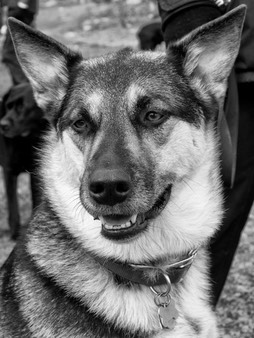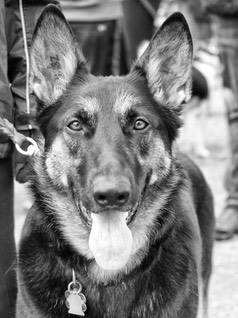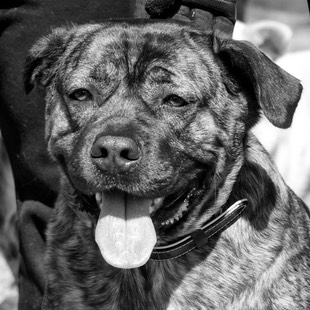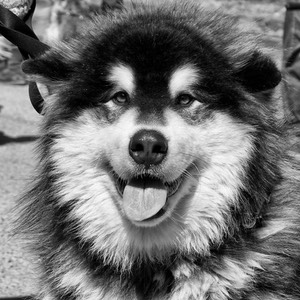Prelude: I wrote this one a while back for the Newfoundland Herald. It is a topic I have visited before HERE and HERE yet it is a topic that keeps coming up. I am honestly boggled as to why people are so willing to accept the absolute untruths alluded to in dominance theory and so resistant to accept what science has shown us.

I have recently been involved with a couple of one on ones where the topic of dominance came up again and participated in a conversation with a gentleman today who called asking for advice. All prompted me to share this information again. So here is the article...
I have been a trainer and behaviourist in this province for 10 years. A reoccurring theme presented in far too many client consultations is the idea that their dog is trying to dominate them. Clients express misconceptions that their dog does not come when called because it is being stubborn. The dog jumps, mouths or pulls because it is attempting to “be alpha” in some imagined hierarchy. Unfortunately this type idea has been propagated over the years by celebrity trainers like Cesar Millan whose mantra of “exercise, discipline, affection” and his catch phrase of owners needing to display “calm assertive energy to achieve a calm submissive state” in their dogs resonate with some people.
Ideas like this have set the whole dog training industry back years.
Why is this?
Because it is utter hogwash!!!

This approach to dog psychology came to prominence in the 1950’s and 60’s and had many proponents. At the time, it was backed by a study of wolves done by Dr. L. David Mech. Dr. Mech’s study examined a pack of captive wolves and drew a number of conclusions. The study concluded that wolves operated on a social hierarchy where members were in a constant state of fighting for status within the hierarchy. The idea that the pack was controlled by the strongest and healthiest members where “might makes right” was presented (Mech, 1970).
There were many weaknesses pointed out by critics of this research. The fact that these were captive wolves being studied in very artificial environments was one of the main limitations.
Proponents of dominance theory unfortunately made an even larger jump than the researchers in this study. They generalized the findings of the study to our own domestic dogs believing if the conclusions drawn from this research were accurate among wolves, the same could also be generalized to the domestic dog.
Many of the conclusions were later refuted by scholars including Mech himself (Mech, 2008). Modern day science knows that wolf packs are most often family groups. The groups have similar rules and dynamics to the modern human family. The idea that “might makes right” is pseudoscience at best (Yin, 2010).

Despite all of the invalid assumptions drawn from the research, the idea that we humans have to view our domestic dogs as social hierarchy climbers consistently looking to increase their status in the human pack remains.
This is the type of faulty science in which dominance theory is based. It is unfortunate dominance theory persists as there are much more effective, easier ways to explain a dog’s behaviour. Using evidence based practice, one can modify and eliminate problem behaviours without encountering the pitfalls inherent in using a dominance based approach.

How is this done?
In order to understand why dogs do the things they do, it is important to accept one primary concept when it comes to dog behaviour. I introduce it in all my classes and to all my clients.
Dogs commit an action in order to get a desired reaction. If their action gives them the desired reaction, they will continue to do it. If not, they move on to a different action in order to achieve the desired results
Ladies and gentleman, this is called Learning Theory. It has a very long history in science. It has been promoted in classical and operant conditioning and has the extensive backing of respected scholars. Pioneers like Pavlov and Skinner initially proposed the theory. It has stood the test of time and peer review. It continues to resonate in the works of modern day experts such as Dr. Ian Dunbar and Dr. Susan Friedman.
Why is understanding learning theory important for dog owners?
Let’s use the very common problem of dogs jumping on their owners to demonstrate why and examine it from a dominance and a learning theory standpoint.

Explaining jumping using dominance theory:
A proponent of dominance theory would explain that a dog is jumping on his owners in an effort to control them. The more insistent the dog jumps, the more dominant the dog is trying to be. If an owner accepts the dog jumping on them, they are showing the dog they are lower in the pack structure and therefore hold less status than the dog.
Subscribers to the theory would recommend taking control of the situation immediately. Show the dog who is boss in the home. Pin the dog to the floor, get him to submit and the jumping will stop. Order is restored and crisis averted.
There are many pitfalls to this approach. It promotes the use of harsh measures and has the potential to cause issues of fear, confusion and distrust in the dog. The use of punishment is a slippery slope and, in most cases, it is unnecessary.
Explaining jumping using learning theory.
Subscribers of learning theory understand that a behaviour like jumping is something that has been accepted and even encouraged by the owners. The dog as a puppy learned jumping results in attention from the owners. As the puppy grew, the behaviour was reinforced by others. When the dog became full grown, jumping became an ingrained behaviour.
Proponents of learning theory state if you wish to modify or eliminate the jumping, you need to consistently modify the reinforcement and teach the dog new behaviours. These behaviours are desired, are counter productive to the jumping and will result in the attention the dog wants. They will tell you that when the dog approaches, teach the dog to sit or lay down. If the dog jumps, immediately ignore the dog. When the dog sits, lays down or has four paws on the floor, immediately give attention and reward the dog for doing so. Eventually the dog learns that jumping means no attention but sitting, laying down or keeping four paws on the floor means immediate attention.

The strength of this approach is that it does not rely on any real punishment. It makes things less confusing for the dog and has much less chance of creating other larger behaviour issues. It is win win for both dog and owner.
Let’s put dominance theory to rest. Let it go by the wayside much like the idea that the earth is flat, tanning is healthy and smoking has no affect on one’s health. Science tells us differently. It shows there are better ways to explain and address behaviour which do not have the pitfalls that dominance theory does.
When we humans accept this, we will be much further along the path to a healthier, happier relationship with our dogs.
Don’t our furry companions deserve that?